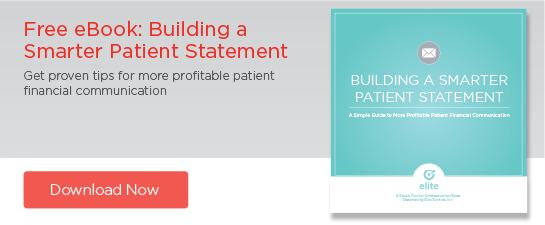Scarcity, Bandwith, and Smarter Patient Financial Communication
October 30, 2015 •Brian Watson

 Providers spend ample time and energy ensuring that the billing process is as fast and painless as possible for self-pay patients.
Providers spend ample time and energy ensuring that the billing process is as fast and painless as possible for self-pay patients.
And yet 57% of consumers in a recent survey reported allowing a medical bill to go to collections. Forty-five percent wait more than a month to pay. And medical bills make up a majority of the debts referred to third-party collection agencies.
Providers want patients to be dutiful about bill payment – quickly responding to financial communication with accurate payment.
But the reality is that many are struggling to make do with less than they need. People are busy. Money is often tight. And attention and memory are limited.
That kind of scarcity – whether it’s a lack of knowledge about how health services are billed or the financial means to pay an unexpected medical bill – is often the major roadblock to prompt payment.
How exactly does scarcity affect patient billing and payment habits? And what tools can be used by providers to build empathy into revenue cycle ops – smoothing financial shocks, simplifying payment, and providing much-needed slack?
Take as Much Off Patients’ Plates as Possible
People have a finite amount of mental bandwidth – or fluid intelligence. Scarcity monopolizes focus and makes it more difficult for us to shift attention, retain information, and execute self-control.
When we diet, calories are limited. When we’re juggling multiple projects and tight deadlines at work plus responsibilities at home, time is at a premium. When we’re stuck trying to pay an unexpected expense, we tunnel in on financial issues above all else.
These kinds of scenarios – common features of everyday life – tax our bandwidth. The result is that we neglect other important stuff and focus on what matters most in the moment.
In that context, it’s a lot easier to become snagged by procrastination or forgetfulness.
For example, if I spend all my attention and focus to meet a tight deadline at work, there’s a much greater chance that I’ll put off filling out a financial aid form until later or forget about an upcoming due date.
That kind of tunneling has clear implications for providers – leading to some of the common roadblocks that slow receivables and drive bad debt.
A smart, empathetic way to offset this tendency is to take as much off patients’ billing plates as possible by automating financial activities that generally require patients to take some extra steps – such as applying for financial aid.
- Use patient assistance screening analytics to front-load the charity care process, proactively identifying patients that might qualify for Medicaid, charity care discounts, or federal HIX subsidies of tax credits.
- Provide up-front, face-to-face financial counseling – including hands-on help filling out charity care applications – to patients that meet eligibility requirements during an initial financial aid screening.
- An abandonment rate of 50% or higher for mailed charity care applications is not uncommon. Reverse that trend by accepting and approving charity care applications over the phone.
- Use presumptive eligibility charity care to enroll patients that qualify for financial assistance, but have outstanding balances that are seriously past due and are unresponsive to other forms of financial outreach.
- Offer payment plans to patients that meet pre-defined propensity-to-pay characteristics during an encounter – or by including an enrollment application with an initial statement.
Create Scarcity to Spur Outcomes
When faced with scarcity, our natural tendency is to focus.
Hikers on a long trek are much more efficient at rationing a bottle of water or granola bar than someone with easy access to a refrigerator. Similarly, the threat of an impending deadline often improves productivity and the quality of our work.
In a patient billing framework, scarcity can be artificially created by smart use of deadlines.
No one wants to be sent to collections or risk a negative item on their credit report. But life is busy and time and attention are scarce.
So it’s not surprising that 38% of consumers who reported paying a bill late in the last year did so because they forgot the due date. Or that another 21% said they missed a billing deadline because it was a “hectic time of year”.
Put simply, in a world short on time and attention, long deadlines are a recipe for trouble.
A patient that receives a statement with weeks until a due date often puts off payment in the short-term. There’s simply no pressure to focus on paying immediately.
Unfortunately, if a bill isn’t addressed in the moment, there’s a much greater chance it’s eventually forgotten – confirmed by the survey data mentioned above. And that has a direct impact on accounts receivable, with providers delivering 3.1 statements on average before collecting payment.
But if that same patient was notified 24- or 48-hours before a bill due date, scarcity of time becomes a motivating factor – and they are much more likely to take immediate action.
The key for billers is to break a long deadline into progressively smaller chunks. Things like prompt pay discounts or periodic automated reminders create focus for patients and help motivate payment outcomes.
- Clearly highlight expected due date on your patient statement. If the statement is past-due or a final notice, escalate the potential consequences of repeated non-payment using firm, easy-to-understand language.
- Use prompt-pay discounts to create a pre-due date “deadline” for patients.
- Create focus for patients through the use of periodic billing reminders and updates. Delivering automated email and text message reminders can help create focus for patients facing a potential late payment – an essential tool to bring the 59% percent of consumers who have neglected to pay a bill because they forgot or were too busy back into the payment funnel. As an added bonus, auto bill pay reminders overwhelmingly improve consumer approval of the billing process. Nearly 77% reported bill pay reminders would increase their overall satisfaction.
Don’t Make Patients Learn a New Skill
Healthcare billing can be a complex process – even for those that have a good understanding of the process.
In one recent study, people with employee-sponsored health coverage were asked to identify four common billing terms: deductible, copay, coinsurance, and maximum out-of-pocket. Of those surveyed, only 14% correctly recognized all four terms.
Respondents were then presented with a hypothetical insurance plan and asked to determine what a four-day hospital stay would cost. On this exercise, only 11% came up with the right number – and just 14% were within $1,000 of the answer.
That inherent challenge is magnified because medical bills often aren’t a regular billing episode in the same way as a monthly phone bill or electric statement. According to CDC data, nearly 64% of U.S. adults had three or fewer visits to doctors offices, emergency departments, or home visit during the last 12 month – and 16% had none.
So there’s already a built-in knowledge gap. And many consumers are simply unmotivated to spend the time and attention it takes to get up to speed.
To reduce the innate confusion of healthcare billing providers should embrace simple, painless patient financial communication – that doesn't require patients to learn a new skill.
- Simplify your patient statements as much as possible. Replace insurance jargon and complex medical codes with plain language. Make payment terms and channels clear. And consider summarizing encounters into single line-item categories – like “Charges”, “Your Payments”, or “Insurance Payments”, for example.
- Offer a consolidated patient statement. Consumers are often confused when a single encounter results in bills from multiple providers. Consolidated, “one patient, one guarantor” statements that show patients both hospital and physician charges on a single document reduce confusion and the risk of late- or non-payment.
- Provide online resources that make it easier for patients to manage billing and payment activities, such as cost estimation technology, detailed payment histories, billing FAQs, and tools to track and analyze total health spend.
Help Patients Manage Budget Shocks
It’s easy to get trapped by scarcity. And nowhere is that more evident than household finances.
Roughly half of Americans are saving less than 5% of their incomes, according to a 2015 Bankrate survey – including 18% that are saving nothing at all. Not surprisingly, nearly two-thirds of Americans lack the available savings to deal with an unanticipated $1,000 medical bill without resorting credit cards or borrowing from friends or family.
That savings issue highlights just how challenging it is for many consumers to manage the budgetary shocks that often accompany unexpected medical bills.
Seventeen percent of Americans have experienced serious financial issues due to a medical bill – with 11% claiming that they’ve had to use up all or most of their savings to handle a healthcare expense. And 4 in 10 Americans report that they’re “very worried” about paying for healthcare costs or insurance.
Despite that concern, many patients find it difficult to save specifically for out-of-pocket healthcare costs. After all, if you’re worried about paying for everyday necessities like food, heat, or housing, there’s much less chance you’ll put money aside for something that might happen down the road – like a family member getting sick.
The result is that patients often borrow to cover a healthcare-related shortfall, but just end up that much further behind when the next medical bill is due.
As health costs continue to rise, patients need extra slack – a buffer against the potential financial shock of an unexpected medical bill that can leave them unable to meet payment obligations. Providers can be responsive to their needs by providing open, transparent pricing and smart financing options.
- Provide a reasonably accurate estimate of patients’ financial obligation prior to treatment to help them better anticipate and plan for the out-of-pocket costs they’ll ultimately be asked to pay.
- Offer low- or no-interest payment plans to patients that meet pre-defined propensity-to-pay analytics. Giving patients an option to pay down a bill in installments over time helps eliminate the budgetary shock from a significant expense and creates a buffer of slack that reduces their financial scarcity and credit score risk, helps you more accurately forecast revenue, and reduces bad debt.
- Make up-front financial outreach available to patients all patients, but especially those segments that may have difficulty meeting their financial responsibility. Proactively engaging patients that meet propensity-to-pay requirements can both improve patient satisfaction and accounts receivable by ensuring that at-risk patients receive the financial support they need.
Get Updates
Featured Articles
Categories
- Charity Care Management (1)
- Compliance (2)
- Customer Service (8)
- Digital Front Door (1)
- Direct Mail (6)
- eBilling (1)
- EBPP (34)
- ESL Statement (2)
- eStatement (1)
- Healthcare Channel Partner Billing (1)
- IVR (3)
- Mobile Payment (11)
- Online Billing and Payment (6)
- Online Patient Payment (17)
- Outsource Print Management (4)
- Paperless Billing (4)
- Patient Engagement (2)
- Patient Friendly Billing (21)
- Print and Mail (7)
- QR Codes (1)
- Quick Pay (7)
- Security (1)
- Self-Pay Patients (9)
- Self-Pay Revenue (4)
- Statement Design (32)
- Statement Print and Mail (1)
- Statement Printing and Mailing (28)
- Statement Processing (36)
- TransPromo (1)
- Up-Front Billing (1)


